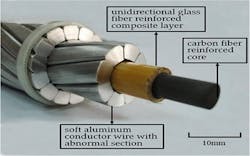Buzz around technology that could transform how utilities build transmission infrastructure to address emerging electrical grid challenges is getting more audible.
Three companies pioneering advanced, high-capacity conductors (see Figure) have just joined forces in the Advancing Modern Powerlines (AMP) Coalition, aiming to promote their utilization as a cornerstone of efforts to modernize the grid. That comes amid recent growing expressions of support for advanced power line projects by the U.S. Department of Energy: Energy Secretary Jennifer Granholm’s lauding of advanced conductors at a June Electric Power Research Institute event; elevation of reconductoring and rebuild projects under the federal Infrastructure Investment and Jobs Act; the chief of DOE’s Loans Program Office signaling support for applications for projects utilizing high-efficiency conductors.
While varying in design and materials, advanced conductors generally utilize carbon fiber or metal matrix composite cores that greatly increase the electrical carrying capacity of transmission lines. That can offer utilities an alternative to wholesale rebuilding or replacement of existing infrastructure. In that bargain, they get upgraded electrical transmission that, by some estimates, delivers 50% to 150% more current along with efficiency improvements of between 25% and 40%.
The advanced reconductoring approach is gaining momentum as concerns mount over the grid’s capabilities. Amid rapidly changing energy supply and demand factors tied largely to growing reliance on renewable energy sources, the price of improving an aging and insufficient infrastructure is getting more scrutiny. While next-generation conducting technology could carry high up-front costs, it could help future-proof the grid as new power priorities and demands come into play.
The AMP group will work to make the case that a higher initial investment in advanced conductors will show a clear payoff, says Zach Zimmerman, research and policy manager of Bethesda, Md.-based Grid Strategies, LLC. With an estimated $10 billion needed to replace or update transmission and distribution assets nearing the end of their life and a decarbonization and electrification push that will require a doubling of transmission capacity, an alternative that rests on a different equation is needed.
“Going into this phase of transmission rebuild and expansion, conductor technology choices need to be based on their net benefits in order to achieve the best results for consumers,” Zimmerman says. “Historically, conductor technology decisions are made based on a least-cost methodology – that’s a policy change that will have to take place at the state and federal level.”
With Grid Strategies helming the effort, AMP will work to encourage utilities and their government overseers to adopt a different mindset on system improvements. If successful, that would open the door to eventual increased utilization of an advanced reconductoring approach to system upgrades that has been achieved in selected projects around the country.
“Policymakers need to understand the potential of the technology and the levers they can use to improve outcomes,” Zimmerman says.
Any shift to widespread adoption of reconductoring will be slow in coming, giving utilities and their electrical contractor partners who assist in transmission and distribution upgrades ample time to assess the potential impact.
“Electrical contractors and design firms working for utilities should familiarize themselves with high-efficiency conductor technologies and their applications – these are tools in their toolbox,” Zimmerman says. “Reconductoring and rebuilding can more quickly add capacity to the system because there is not the need to acquire new rights-of-way. But there will still be a need to build new transmission to access new renewable generation in remote areas and to increase reliability and resilience between regional grids.”
Tom Zind is an independent analyst and freelance writer based in Lees Summit, Mo. He can be reached at [email protected].
About the Author
Tom Zind
Freelance Writer
Zind is a freelance writer based in Lee’s Summit, Mo. He can be reached at [email protected].

